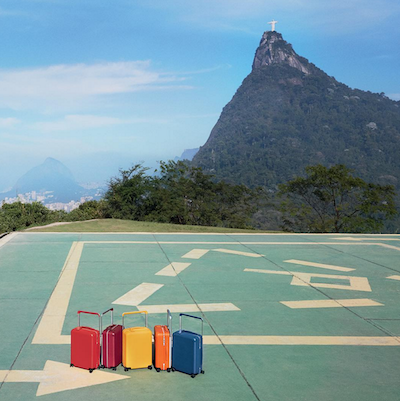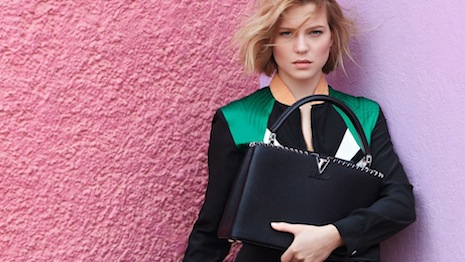Leather goods remain a lucrative product category with an upward trajectory that is expected to continue at compound annual growth rate of more than 4 percent through 2020, according to a report by Technavio.
As the primary pillar of many luxury houses, the leather goods market is expected to reach $258.4 billion by decade’s end. Technavio’s “Global Leather Goods Market 2016-2020” report analyzes the market in terms of revenue and emerging trends, as the demand for luxury goods is interconnected with the sale of leather products such as footwear and accessories.
Leather love
A driver of leather goods is the durability of its material. For high-ticket items such as luxury handbags, the assurance of quality and long-lasting durability is appealing to consumers.
By product, Technavio found that in 2015, footwear lead the leather goods category at 58.35 percent of purchases. Handbags and small leather goods such as wallets comprised 23.92 percent of purchases and luggage at 16.93 percent. Accessories such as belts only equated 0.80 percent of the total market for 2015.
Footwear is the largest segment of the leather goods category, led mainly by athletics brands such as adidas and Nike, who have begun to focus material use on synthetic or faux leathers. Doing so will propel the category’s growth rate over the next five years as the materials are less costly, more durable and align with consumer consciousness as many are foregoing animal hides.

Gucci Ace sneaker
But, for the non-athletic footwear segment, leather remains a vital raw material. As the quality of faux leather increases, and the availability of additional color choices and textures become readily available, luxury houses may swap authentic for synthetic.
As the decade comes to a close, key markets such as the United States, China, Japan and France will see significant growth in leather handbag and small accessories sales. This segment of the leather goods market is expected to see a CAGR of 5.43 percent in the next five years, according to Technavio’s findings.
Power players include Louis Vuitton, as the market’s largest, followed by Coach, Gucci, Prada and Hermès. These five brands and other premium designer leather handbags dominate the market.
Likewise, the styles put to market by these brands influence the tastes and preferences of both affluent and aspirational consumers. Social media has worked to brands’ advantage, as the various platform available allow for advertising in a climate where trends change relatively quickly.

Prada fall/winter 2016
Technavio found that, following tote bags, clutch, saddle and satchel style handbags are the most popular sellers.
Many of the labels known for their leather handbags started decades, if not centuries ago, with luggage. Louis Vuitton for example began as a steamer trunk seller before developing its handbag offerings.
Leather luggage is now seen more as a fashionable accessory than a utilitarian necessity. New leather luggage products are being designed with comfort and convenience in mind by fusing design, shape, weight and innovation to meet today’s consumers’ needs.
For example, Louis Vuitton recently introduced an innovative range of rolling trunks for the 21st-century traveler.
Louis Vuitton made its mark as a steamer trunk and luggage manufacturer, a heritage that is often explored by the brand in its advertisements and collections. The luggage collection, “The Spirit of Travel,” aligns with Louis Vuitton’s travel narrative as this is also the title of its biannual campaign.
For the creation of the luggage collection, Louis Vuitton worked with industrial designer Marc Newson (see story).

Louis Vuitton's The Spirit of Travel leather luggage collection
Technavio suggests that leather travel bags is the fastest-growing portion of the leather luggage market. For the forecasted period, Technavio expects the segment to post a CAGR of 6.8 percent.
Accessibility beckons
Although leather goods are profitable and in demand, some luxury labels have struggled with market saturation, causing strategy configurations.
Michael Kors, for instance, announced its plans to scale back department store retailing to protect the brand’s overall image and profits.
According to WWD, shares of Michael Kors increased 8.3 percent on Nov. 4, but despite the rising stock value for the second quarter of 2015, the brand has seen a dip in the department store channel. As a result Michael Kors will pull back its inventory in department stores mainly to avoid its merchandise being placed on sale by its retail partners (see story).
Offering luxury goods at an accessible price point has also been a tactic developed by brands to boost profitability. The accessibility level may also help entice millennials to buy at a younger age, and when more established and financially secure transfer to higher priced goods.
Italian fashion label Trussardi, for instance, is showcasing its enhanced focus on its leather goods business with the release of a handbag designed to be a constant companion.
Part of the house’s planned five-year transformation toward accessible luxury, the Lovy bag features the craftsmanship and design details at an approximate $600 price point. As the luxury industry seeks growth in a difficult climate, a number of brands have reorganized their businesses with profitability in mind (see story).
{"ct":"Wpqf+3w9SQ2eQNvnCrlhKJ+9DRxDXcDSDfap6xBpBdGyc0eFzZxEvJp5YjbNlx0MfyrIxRgQ2dr7rrsHt7bW4YffHrGbtojhTcm2RpW48tjR5j1pMa3WBwDekjmczSdds6RD89nI2qYvC9SRESxZjJa3divhtyuD0FCWB6Y\/\/gT41xiFPcYvq\/EFrESdxslL5iF39Kqq8rPJYmHObjwgFtjwBmnjPoPq6Cmgzht+r4dodfq0jgt0xnyVdMY82\/qEUPOGAoRBupdi00+53mIK2I4hzb0cstEgSkxRQGOij8qCqxGc8Z2Yz\/7VhiAcvrtvk2mA\/7QLBsFLL\/PxSv0kptzJCBNM685k\/d61fQb7K3nG6BHfHyQFI+DWX+0UijaRRG1AFpbG4T5DHe3TOQFU8tEwgPW2Awvf1MCuTcbeQGz3Cwl66V2Up240K6bR9fASN6oScZRm0apHNSS4GaC\/K1iEX4uyuTjjnohkql21okwy461iaOV2CtRAUPYuHl\/fW5szzXewkS3b5QNH23WbNLAk+0C5qbf\/7RmbAYmj9NZ2mLjkasZKbQ3jltNvWvuJhQeA9fqrZi4y388ReRhlsDFF3mINruhlFcLljFs3lrSp7C80ld5zxJi5Afh989UOke5TpNOfpS3UV0KLJ4DaEqgN2qHvh1Xlz8+SLq4g28qIEuuVvtMLIJNt0E9Gqr3ogmSPHk93ILoaIurubynVB3HkN7\/miWwnqIhCLGvY1mnlTIQ9o3VlMbNtye330kGEqSOGXZ7dWjapt0DmDYMI4Bd08mveqny5TmYJEAo6hwnFL2vS1N7CYlvZh4TgyIfHIAkO9qUW1myWeAQS\/aXT\/24\/\/f8uOfOVNFkZ8Zvwmr33CNP9i4af23WfOoCLg7BcBW+RbjdAWm4kZs8VLFKMUe4JpCH2Ab1U9hJAyVsokpOHOVc8s\/HiHBm1hjaJ\/pLmhr5yN\/7oEytOHnXVWW9OnDappLndNKOVNlU3QH7a0MQ3e6HHUGrfBI7AcGVax0rlfjl6Aw8YQA6MioZdyw0LFKRl9gCLJBQJYMVg02li4TNBwXBEyAnBORvawJDffoPbMCE7NdY4Pz8freHGYNVIaUS5CQ7om05WYL8MzkvLt3\/y1yR1GMbCKDZCUynhJxsCXEvOSjCwY0O2rIWOynHxylEvKXt0cwV1wHgRrBZmpjClYC6jSVHlpvSMBXpO3IgLsCA6To4rW3Wtp1R3LTiEQHdJHto3TAPSAzgaesOWTCKoiC1\/t9i145U3mID0CoattDDQ50mXICY9yc0yj5vh8PUuI5tZD3RHJnzZzDih78y5kyxzF4LRgkHZrwi\/Th5uZG+OkglfYvH8uvzSMi1jmfO6ldR4Md7OzWtWW\/w1JKMtK31lHTncA71H45MtYQtWcRhV2Q8DpzpSmQXqTNGg\/gblR6A+0Jby7\/VEOnXgiauG7xNAV0mSRlQ3NNWmPLf\/RI3ecnK\/thoG267oyZhBoRv2iMamCnjxvLE7GpKSrwEVolEyftgdnTcHeDWL06cCkEZRtOnNEaZI2sKt6mOUQ+ogvgYcuUGOvHNsSC0bLl+iWa\/ERiva1Wr+a4Mom+UCLeYAfxwpLYOqZxvLvpw9PBpd7KVjWjZnqmiyZd9bwzCi1PUR4ukS0g0S1PW+5s2ti\/pZmGbmydXcn42PahPPTR9hmApbLr49omx2vrUs14YV+WekYjdAJw2iITBTuB5vInOH4iuasU9ViSndy7z7G547GQQ3silcwJ\/29yP4AMNsL+rURY+ZdyHUYvR7bFFSoRIyb2Lb6BNydaXAHL4UE9lOkridoJnXo2GHgNdG\/hxCKVFq4gL9H5lCm5\/lPUcBaC10bqQT4Q7hKJAhAqrGEN7Wqn+3rM+xRTC92ZSCveprZEh2CEeKaGPJalkAg9iSU2MBjXLdntopSxVpWb+EG00S5k6b\/mnjcEr1NKg2hgVcV75IvOmw4Gbz7ZC2OVKOR+Ny\/p5OpTkfi5B9v\/jOTpJ\/GlarlOwEa23IqOEBrl5wHIh3NhtqidLmxhQRZTuUHeASjNVHqcoTpNHTNgD2DqCIJS6v8o5atxhLd26MmVbZGQVElnwzglXZbwLTp8rYdBHiv6r8Uns2I0RMLitgDePrGaO96WFv9MBAq6WV4EXaT6Q1GK2bV6CoClOBSbeux5eldKsn4Zjwfr3SzbOQI6yx9Kn3ib9i0d+uzLCa\/CRtBquVDPh64x5a\/5MOq59oBqFt7aqQpnPP3YqQHMLHnlrHlMX1It7a6fWK72WdbfK+aF+gwogWg1CQGOinEcOIW1KcS1QZv0PN7IB2vIqg86dKkOhrypreoVMvoxh2tzcKuXV7r6MA0BqE7Z6blkwNKgX3X1w8hRKK7LaLJQwGGnEd59z1DjbLn2y6pelI55p4++nD2TONWfcI9GiHUxeOPpvEMa7+\/MYZ7TQQtVxFuka60dlcNHqyAlvXciJPKSuRFJd3kwxWeqwUAP4LRf5yIqT76P4ck\/c2MFXLvHAgmHfFZCzrH2YqnlRx2hnf3kq17mI2mv1dgP+m2UNyEuIHXhxUI\/97YSE6PUQrhl1VE7KQWBrK4AfA1bONdS3uZBAVrNtWPDTZkAba8CYgdKSQBPNJmaxLiff5SKYHfuu\/43zUkXwWZLy+qVyZWhsesBCxyVphNqvboIIpDjlUoV+3\/2O4+bRvl6h+XSbUHaUMslnbKPvutF3Hi++dRDU0POgmE6wE2grMlL2yv97oRYuLI12GP5oI9EJQI337\/co6vB2xyxnuRv6b4JN3PkXy9HnFcAus\/PUwF\/7BSfJfLFWpR7pfzGUqPYHMwOX1Td9lSQbmmuAKua\/FOoNnz1qrQST45nvrg98\/tF1NxCoY8K7QyLAxN1Z6I8+e1qzqVIZUMI1LhKuhVrpIX7DE1s\/Z2YwX5qsb8yII1gwZGsB0HnjW1Nqwzz+MDLA3Q9mKB3UXKiGKbent7i4caaCIiARLw86qiwNDdgszJOT0NbGN3jvEkN0l+p4o4\/ylPcWUPZfVAvViyRQY3Hg3puKP0GTHxace5tFe4Aepb6wGPUlctD7V9Wqrgch6ZjgJH77AVmBuJHJWFoqA1lkYDTDA3svIGLX+HLjam7if8w6LaClVqD4VdNaQ6sHv8\/NNMqQjXMi15QVJ+iOxd4GcqxnRKdXqDDkIpWWXAXAqcqRItbWIP1Hqir9fGz2gz9sQ1iGcvkvn6MPbW5uQ7iD59b0QlDnkHdmqp1LcUw5\/yhf4W86nU0xntvzHaER92sDA8VzxU4D21Dau8DXVwnjb8Pd+MCWBIzYUA+ZGDJG8uZWGybgUs0uhvTRbM9H\/VJfa5Rl78I9Q6gWD5wzSfX4Whp6JhqPbGytrSunMjraCRQyTcUtVMXvWuIEKibXJF7\/qvNlJ5ASPj3OZt3I8ql67uLl27Qla11H\/WTPHwWeKaxNjwKZgxQ8dnBBLiyGomWISD1edzjQ3Rc3q9CR5Z8VFlZC5Vay4o+nDkLfo5cb46OjnPjcxMz\/p1o8mChSTvkBesSS3r5fFgU34UlEE3zYQ+HxjS2CXx5TkSoHYXPJTPBhK8AB1QMOd+iyoEUi7S+SguJRQ1fDX0PxbCorcO\/YVjlUUT2ARb1xjx5Ur+m3Bb0Gqgqij4UAlPffFzigpL1pZRhQhEnAII7r+feVvcp2Tc0QE2bOAjhYkbXhstmOuHQlPfsnxivGtL9tkspX2BaxxytUgkd0qVHRT9mo0TBkvgCV5an+7DaBGQR1A+schsBR7VOVahVsAIuIM+m65ddx1f2fjKKE1ewSiC27tMlW4eQSmaDCe3FrRh4K6woDaq7Sj9pmXZEGPR\/PSa42TV7VYpKDy9UJdGIRTynLQKN4x+2xWU2ofevcoIjAlzWgiWiAbo8qvHUZnwXKXgQcVmNyEmz+TOMu2sk+FuUnR+iieZhd3EuSL\/MqJpK8hiOsEX6LUnmAWxSswhyglyHy5gr7Ky9MchYZz3iJdtMlE7iE9tVbLeaj\/MIJcPleqaINDqNp8x5QNKTDWD2IGWx4nWRjBj+Jx5Uefx\/HLujyYeLxHdWo86oXifNxLKaj\/qvRTIoX6ZPlBN6wTvVRt8qV5QWlXa7uGvy3avP6PxiFayTTU\/hg+kyv\/WQ6dnwm\/i4Cf1jDj\/1OS15Mqk0a1BZ5\/qzpjz21hMO6c9Dq0fX\/bV9yguztfZ9zQ0qAexJFfrB5mPjfh7ufk7XyUKRLWiCcP9LgpXmLvq6nNxRCX958JXn2CZr3fcvz4aXLn+Lpc760OTzOjO1oRjH59K8to19M44mtRIQIQNvOk6LyOEW9IcN\/ATTSQ491c096ZnkA8hfn5T00FkOQNvuYOKZXdvy\/T9HYLn7kC0bTWhkiPpOYL6170Z7615aQdYPG\/vr15cklL4k6pUqyixYQwsCQDIJpCvpchmX7vGZmcz4mT541kxizx\/1xYcJKszyC8n9MzTFmzoemlK4PY6\/SHJf2zRh3ZlD3ZQnEjrPgHZj92HTYWpWmPcaH3fzNbfZaPPSUfmFkZtF6cyEvvqqUWQT9V4Rg9Mr9EPvMak4FY4x8ELDvXojMZnscPmc2Z\/o+1ogPiNV1yGxVqGSXKFw4G+22bsIpyM\/6+4S0hg19aulDqM4RuTrScSugxNlCbaentNn7Bp+msA5\/nrCkmvr4ZxiRJRSSOSvQ4PnQ5aCnyGSqoWKpxdiNj2gm2UGZdNTV+eCuXmMGOJb3kschgxGCThOwbku3\/CItbJazZRHZsUjXHx40RyCtD5SvT3ehcjnw0lgnBdP4GCfo5u6ZZZyjXJDm3OtjGo7vESJfqcx65cH3ALMigfXDlgQk89Elm+rJfXqU0vMhu\/6EgQRzta0SKaLQ9vmo2rDT5QaedkPQiyjwLX1BkJhMWqhpISWjeNyTJi74k1f11EBGMb70dEeRLrjNhyfkSexx6TJSAL2vam1SDhPwej2gz80bc0CyQBl1aS8di+MhlRiBRZRww+ALQ\/i2Y5xHAOCvAa7bw+y+b6L1Rq3N\/35\/bUgIe4\/lbPTdQ8JhwgXh9NE+M0mRsvVboPxxNiVytym8Cwceh477ZCTCx5pds0Me6eHuu0bUHLy\/wurrIT4NqeIW\/aDu6xGpnRRaKtg80WCtLMeaZugEL6U3xnMM4+EU+MqAxvbLLe3O5xyTes25wqx\/uqZKIr7wBxDuSRPGNR5BgrKUT7XdyfcbjfCaY2gvwGs6HxE1RzMbOTcV4ui46S78F5p0IeIp9KBsfnUO+6FNhTJvyzypcl7ccTOicPWjUw9U3JkZBU86bYp6wKQ\/8MMFsPnsGxj1y3ibPWU\/ttHhBeTwzvl5JB7vPVBO69OYtp4\/WUQJbG\/UkhS6qkP6o+ZyuvxqoSFAOkDexJKvmt8l3cKEmWjAIaKOOHEM2e\/vzd1nX6Mc7027tbmz8OL3q6b\/ONs5N84fUW7FkB4b26MO\/S4h2NbrlP6NSWPSnhE4lYVWkfVqYIyYrogrdyu+4TJ2MIhfmZtN2f7jhZVTx58CT3kqnI\/EtzIh1l3kTNvQCnneJtAObv88TOa7sz8IfZYC9gy45eA6u92iqcOjtabCURXWl2piZdCO9HueUC1lDrA\/beWMQMYcoT+3F6M0ZFN5XeqPmkFIQuFFdE9DXN4R1rrvSoy3gKNMMhmET7R8XRZnhKp1VijRwGCF5yyvOVxyqPQQCjM10Q0PbtLuIpzaEHWCuE5BrmoqVoQZXY3ihIgb07YOsIXSy\/G5Gzf1ISADAT4od6jEVfh8dduf2cjV1Cf2Vv\/6piMGgedXznhmDkTrquYCmSK07eRZyvr\/lCsazySKGxbNzVEEdtf9jZFGct+g6WRgh9V83r\/+HDvWlnAmTRYS5ridiwTRn+ttQo98zexkozkQ2KKsjjsiNiZ5mKv3Kj+Cv6bMiZb1cwBCkEzl27j7mqh5yqtYhmgz8f7WUgDieTjM10fBUpakeFUfmPOm\/NKJAY6dJAAVlQMPbHkyHdgG7HvbywErj5I3Onl3dcp05erjAKTTtkF2LXnJbY\/XELX\/3TeCoGOml5m8QWgGhKbr\/G0Yi4BqEcMb535sn1Zvr1U1tok3Y7Q3dRhkoQmnfyirmPmRInjrgsgYFB2DY\/m6X4DHmV7\/RCt3NFwKcTvxcLbqra\/nhOow1OUbkBgpS\/c9+fTL1pG8kKYu72yXiiqExjSQ6NbXo5wOY\/E5Z5F0zYP8k4gBeDLVfzwl4D\/VE0a6N2x6uESijRJFHXZOnDKFEAF59GZuEtoXIUjmrY4SVZ9CBuvFK7qRACC1hLiBX1gpZUr078TjtbvjeuXWohEIr1iunU3tVcusDgi1I0h7mjQuj\/HmBJxsBmMi5ZdpAiNqeRAv5qWySxgvME0ncdtxJ4pbolGppkEiRuLaKhI6fyD+dWfQkyx13KCHDeuJBjt21wz+aUDAXYt8Ej+ZslokOBDAwMDBma1jQEI\/ACh755bAHUUBvGO6CATu4VhxNwfKGxPyJFbfecOs3UlmIKnbxeHqKkY4hGpdj1aL3HiwkZ8p5SJIvv0O\/HWeX12ogyYozojWfDdTnOzEWnyqMf9cvQ8sIq0xJz+XbwDimoulmwUINOvvi+eKQAXiQDdWrXSFDR5e\/XXdt+HiRATIS5F25ukvnIq0Ae+JHd44MQsVpOSORE+EGnWQrtEYHWVyfSIt8jLE0Ij5OCWOIBUHIy9xl6q\/qUn7g7SMpiSm5ksSA8JrXSnTFcriQ2uL0w4hg2rXQDKbMZVkBYVNoChBpFl4DxomPDGQ6wSGObUsKpALCegGRpWHMWucGYI9LfRfhvekcrubLyKejIjKlqwvrC9LURPDIP\/Z3S3a7Dwyt9WqLMmEsEaYwFAfZAAWjsmk+uy1GOWJXoqfn84Gf+6c7ZD6eOgZNnbW9\/jmnULjwN3M2wwG0dUUH3l3vXJJKM3d2vxyAHF842SZAvi83Df0F0RYvgP4V9IH2NG50Mbmrf+NR\/r0Agr7G6yQkYqzsUcTEgpaRF4HbIzykJKiPRRU19UasoiG1DyEyL14gLzgFwBMli\/wHUYa5wjy8HlqWoLE0YCnHOV\/elCmwIPN0Q0u\/pOkPPNvdq8vS1RZZzMwqs8mEaUqDprtwf6UWvoOdl0J7UWL2nCMij7XsAxrU9PSIfcq86JKr7ZgddoAYC3LxUB2LtHASQjVnpxPGjo8LDdHTR5EV1dNMX0oHCqHCsuOojMuFGmoKXCjMp8zgu7j3A1FpuRnY\/RgiTTM3ZnVcWiI2YmON5X8CGYOXr51IG6FVcFdZ9Rr0doA\/ctwZAxu4xLx4QqVSM18ACgsRDPTCsDB\/Eff5TBYHtQO49LgWruiZwrNGahTo6s5nRYNjI\/hjqywfm0H0axF9HJ58wXgpJ+0F9xIwjCvIKg9wN26cX5Bej7WHif58O1vVBVltaOEdZqIQ6jNOCesj2DbC7PAqg7AIiPVmgn2Q3tO++l0BOjrnfw+WtSDoXmiQqcs7F86hzsgObjjcd9DE06FpXn4GkfKUSjEGZvnXvHOncF2A57xM+o78lk5rEVYs1HajWBlhH+Ur8LcokWFKJUkDIjPaimg91MnVhe7NHuCIS56csnOpu5\/Os+Av14G6\/qx7ESXhF0fcf8VigapeToNLkGpg1vEnWWcvTgwceDF26wIbyZHONSqmu2JyfheHK5UEFBW8w4AN3wLdBHRX\/ochtoJ1znQlYyQhRcYRIOJuAjLb5GN8GMwxWCaFAgFlA\/kRowCNCX3MmwgY7aYWHQGAVRu6NfF1iYN0Z9OYd3u\/sjRjPbHk7+kPcuBqmqLTiFE4ugSc4BMjpnHYXgla5Ify3+E+97xxEAtYsYllD0Zq20OffbYe3ejK9YBhDjP5Vk6hRPncmcjBnwtmf0QEMrBX+odR0bRpFftfLi5xab1Jth5khXcw63mmzhuqxOslSD944GA7ZmCdfWVyLL8JxsWpzGMy9Lw85zP5cKIOcdWoveII2GLoZXMgRCPqB1IoADo77O97f2WtXw810kh7DI0DBgac8n0gEEfJc\/+++CuQpVbyxj6H9ZCJovmI0hslm9K1wTJh7Ic4IbjY+jO6MY+lEhRsTqfHka\/taMFY6XXjFXPGhqg4Osm2WtJHT9APCRh\/WsrBGc976Nk\/Vs7BA7eFyQL8eiAECqVOIwqM6geNrbSJg60Ffxh3xhCuFMvNGlfdxxa2yrGaIN5ZmVTgD8iWpV8U8f3N1DF0dUAlGMCNraDbg5xACtTXN5HhwArIUJ4+lueRF29LNVKdoDYMQHokMlHINmLGF0Q3e8YKRkN37F2N5tlPm\/IgWbXhuRWfEDGC9tpM7H86uGxFfiU7yxQu+qrAM6vXTammLsA2RPWTXlCBkfx3FXlJbw3lCXyCMWH1EVF8IslVt48ROG\/sKrkl5WGHcx85g4LE9bsNGqFmSudUV53QgW\/U3Y9r\/xw0Hpuu0orsSYfDwMXaG+2+iFXhasOO000MiBsdc23TMgwLtGE1j8AlCyGwYhYVMzqwsqEPy4eJdH4CiZUFe\/7MVyZblql+cVwrxPUhdxWax9jY4SB58Q7Kxmirgtv7UmDXo4Gha0fjAlZ6Yd3BDVNvCob+Qb4nuzVIdwS7kk5YCf9fvi5fChWdmQdW9owIhpSca9qysEcpfFiHP+Y0a1VET9BCYJC9qDYBRJnln2r5i9jgWfi0vtdmfPsNfwxM0\/UMXj6gdhMfE+Q+iu7YbO0g\/NRAQjNbAiM+OZOyRlZuJdh5FWHXgj8My1kD9j\/7dyhQeJGbclF\/mpQZpMmDfoGhBxuFszShhbInlu+9YvOxe8LmZzBPDEywh\/InBlmSSasB\/zX7a4kQOdNyXnrFX\/XM13tVA6wn\/mKDXktRun13kb8BDKICMPWMxhVa7mCagm1hlqN8YU1aBfZqm6U\/BOeU9fitToHQSEePiGZwlT6c557JPSvwxvdaTbM7sF4NV7yo3yeAbwIiLYQJmj\/qCp9bSuGrCtOEEKTitRiYKSrZCHHlf2y9vfmsSb42WIm7aHhScYyHRfD5LnXoF3ZnGUUZ5S1Sg3c5pOU1RIRSXcS22xd71Xpc78qWW8gqZMG57H0tnWL33duIiHS\/5DONRFbRdoDgtiE8airl\/QWKZZVCiufSZAPq322uc5oWPrp4k\/MyFQj\/SngrMFGGsbSvpy2JPXOZllCJfrmpPZgBHIBV9GElpvqsPG9bleVBDNna70JtPq\/aXq0k00BKuSku34IuehsIilMOrqAOYeLjE3U6sZaMwunHmY0bpT+quwk+uJJXq9HBHEJZsmDqM5ZnuBH6yp\/R5NZLmA4ixSYiyvFCD3irxN\/A4z2bh4uNwdppruf70x5cR\/ZpckjqgepTUomp2XsfCXrU37CvLm7+wckqjeIjsSwfalRyigqQX6\/tHV6ITr5zslGtzdMVBzjCgrcqVfNogwGK+fLC3Wb9h6s2KeSIpGr2WHN8qy9WYvfNl386XI8+Ob+HQFzUDvt9UySnT34XrniQVa21ETL4Gj8r2ZIt0nrkj5M69e2aovnZoGqRWjYnxxSLYcQoaO+lMHQkcvg+eLK8C0eKidfXmF6K0QEKrHBNBWk72qyoNTZK6t11h1uAnl\/cPa9GHBGKINtV9S7e6Gj0UWszj9iGI9zV2kDNnwrtG6Yb4XKx\/mtmdxOToMcA8RsGV59XP7is4nf\/xmn8q\/X9wnWFlv\/tzeD+dPl2CTxpIYOxhE48zQSnel0j43uHhFz8gQuDJWvOzkGF981Y10X9VZxJbp71fWeMKQtfKz8sLOAUbT0Qv624P\/lIPtThmfUgFMsjv1Q3iHeKvZD3pGy3n5G5Fw\/20WNWlb25bd7pN0T4gX2T8cIy5F2FbEx8EU6YnFTaB55dDAuybdhjQSPcVzP+qQ+fr1a3dADxHYFglMncJrYyMBH4q3jBnz1AGhOug4e8oCXfOZ0NwUXWTTcZVokpkqH9pP\/khCtT1M\/cOqnpsGSSAs\/QIlMPBLsxTnSAS\/oS1qQmR5+T6l\/bPxDAXml\/2w2\/TTL99K6\/uxpWoBOGxjZodz1BTEtXXK5qlLnmij9Rbghep4YE5muEdFz0hSTOg+CKws\/MoIUBWROhmBMuKBayFEs=","iv":"551c5e8c1cb863e23121f34833e9d5ee","s":"b7677f0bc337e55b"}

 Lea Seydoux for Louis Vuitton's Spirit of Travel campaign
Lea Seydoux for Louis Vuitton's Spirit of Travel campaign